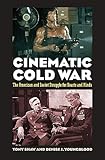Cinematic Cold War : the American and Soviet struggle for hearts and minds / Tony Shaw and Denise J. Youngblood.
Material type: TextPublication details: Lawrence : University Press of Kansas, c2010.Description: ix, 301 p. : ill. ; 25 cmISBN:
TextPublication details: Lawrence : University Press of Kansas, c2010.Description: ix, 301 p. : ill. ; 25 cmISBN: - 9780700617432 (cloth : alk. paper)
- 0700617434 (cloth : alk. paper)
- 9780700620203
- 0700620206
- 791.43
- PN 1995.9.P6 S534c 2010
| Item type | Current library | Home library | Collection | Shelving location | Call number | Vol info | Status | Date due | Barcode |
|---|---|---|---|---|---|---|---|---|---|
 Libro
Libro
|
Biblioteca Juan Bosch | Biblioteca Juan Bosch | Humanidades | Humanidades (4to. Piso) | PN 1995.9.P6 S534c 2010 (Browse shelf(Opens below)) | 3 | Available | 00000117550 |
Browsing Biblioteca Juan Bosch shelves, Shelving location: Humanidades (4to. Piso), Collection: Humanidades Close shelf browser (Hides shelf browser)

|

|

|

|

|

|

|
||
| PN 1995.9 P451h 2007 Hollywood science : movies, science, and the end of the world / | PN 1995.9 P526c 2023 Chasing the panther : adventures & misadventures of a cinematic life / | PN1995.9.P6 C668 2018 Hollywar : Hollywood, arme de propagande massive / | PN 1995.9.P6 S534c 2010 Cinematic Cold War : the American and Soviet struggle for hearts and minds / | PN 1995.9 P613c 2014 El cine documental en primera persona / | PN 1995.9 P624s 2002 Special effects : still in search of wonder / | PN 1995.9 P665m 2006 Making short films / |
Includes bibliographical references and index.
Includes filmography.
Introduction : culture, film and the "new" Cold War history -- Industry, state, and Cold War contours. American cinema and the Cold War -- Soviet cinema and the Cold War -- Sites of conflict. Justifying war -- Pleasure versus progress -- Deterrence and dissent -- Conservatism versus anarchy -- Last acts -- Conclusion.
The Cold War was as much a battle of ideas as a series of military and diplomatic confrontations, and movies were a prime battleground for this cultural combat. Tony Shaw and Denise Youngblood show Hollywood sought to export American ideals in movies like Rambo, and the Soviet film industry fought back by showcasing Communist ideals in a positive light, primarily for their own citizens. The two camps traded cinematic blows over four decades. The first book-length comparative survey of cinema's vital role in disseminating Cold War ideologies, Shaw and Youngblood's study focuses on ten films, five American and five Soviet, that in both obvious and subtle ways provided a crucial outlet for the global "debate" between democratic and communist ideologies. For each nation, the authors outline industry leaders, structure, audiences, politics, and international reach and explore varied relationships linking each film industry to its respective government. They then present five comparative case studies, each pairing an American with a Soviet film: Man on a Tightrope with The Meeting on the Elbe; Roman Holiday with Spring on Zarechnaya Street; Fail-Safe with Nine Days in One Year; Bananas with Officers; Rambo: First Blood Part II with Incident at Map Grid 36-80. Collectively, their commentaries track the Cold War in its entirety, from its formative phase through periods of thaw and self-doubt to the resurgence of mutual animosity during the Reagan years and enable readers to identify competing core propaganda themes such as decadence versus morality, technology versus humanity, and freedom versus authority. They show such themes blurred notions regarding "propaganda" and "entertainment," terms that were often interchangeable and mutually reinforcing during the Cold War. Cinematic Cold War offers a shrewd analysis of how the silver screen functioned on both sides of the Iron Curtain.


There are no comments on this title.